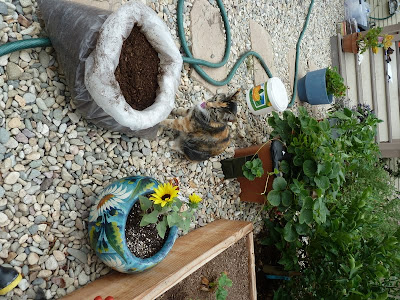The amount of maintenance your vegetable garden will require depends on several factors. Our garden requires quite a bit of maintenance at this point but we have a larger than average garden. There's a lot going on in the garden right now because we are transitioning from some of the earliest warm season plants that we put in during early March and replacing them with new warm season crops that will get us through the rest of the summer.
We are also starting to think about the cool season and need to order the seeds that we will start soon for the fall crops. In addition to that, the general maintenance of our current plants needs to be addressed. I started yesterday with a list of the things that I need to get done over the next couple days.
 |
| The list |
One of the things on the list is to feed our citrus trees. We have three citrus trees; a dwarf pink lemonade lemon, a dwarf sweet lime, and our avocado tree is also considered citrus.
 |
| Dwarf lime tree that needs more space underneath and feeding |
Our dwarf lime tree had a nice growth spurt over the last 6 weeks or so, and it's time to feed it. We have heavy weed block and rocks in the front garden that act as a mulch on top of walk ways and around our raised beds. Where we put plants in the ground, we cut the weed block and move the rocks out around the drip line as much as possible. The drip line is the width of the branches. We need access to the area for feeding and then we mulch with compost.
 |
| I cut away more of the weed block and moved the rocks out further |
I added some citrus fertilizer and scratched it around the perimeter of the new space.
 |
| Gidget is concerned that we are buying too much compost and thinks we need to make more of our own |
 |
| After scratching the fertilizer in, I add a thick layer of City Farmers compost/mulch on top |
 |
| Earwig poop on strawberry leaf |
The list only gets longer as you go through the garden because it never fails that you will find something else that needs to be added to it. Something is eating our strawberries and I suspect it is earwigs. This poop is not in the form of small pellets like I normally see with caterpillars, and we already know we have earwigs, and
they like to eat strawberries, so I'm going to add this to the list of things to do. I will use my
vegetable oil trick on them.
 |
| Moving on to feeding this patch of sunflowers and corn |
 |
| The same idea applies, after scratching the food into the top inch or so of soil, then mulch heavily, and water |
This mulch adds more nutrients to the soil, and it helps retain water.
 |
| Sunflower seeds starting to show, make me happy |
 |
| Our compost bin is not adequate |
This sort of compost bin is best used as a passive system, meaning that you don't turn it, and it will take a year or so before you're able to harvest your compost. It's called an Earth Machine and the folks there do think it can be turned but the process is very difficult as far as I'm concerned. A year is a long time to wait, and it is not enough compost for our large garden. We have harvested some wonderful compost from the bin though, and we will continue to use it passively.
We need more of our own compost, as Gidget keeps pointing out, so I plan to make a worm bin this week so we can start using vermicompost in our garden as well. I'll show you how I do that in an upcoming post. I am also going to explore some other composting options soon.
For now, I am going to finish the feeding and mulching process for the rest of the flowers in the garden. I did the vegetable last week and will check again in three weeks to decide if they need to be fed again. We feed our vegetables and flowers every 4-6 weeks, or as needed, and our trees every few months.
 |
| "So...I guess this fig beetle is my lunch then?" |












No comments:
Post a Comment